Austrian film director and producer Joe May (1880-1954) was one of the pioneers of German cinema. In the 1910s, he produced several popular series of silent melodramas starring his wife Mia May and crime films with such detectives as Joe Deebs and Stuart Webbs. He also gave Fritz Lang his first chance in the cinema. May founded a studio complex at the Weissensee outside of Berlin where he produced popular melodramas and exotic adventures, such as the monumental serial Die Herrin der Welt/Mistress of the World (1919). Later he produced such realist classics as Asphalt (1929). In 1933 he fled Nazi Germany and later in Hollywood, he directed several B-pictures.
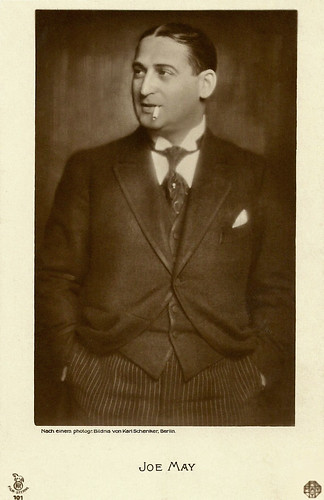
German postcard by Rotophot in the Film Sterne series, no. 101. Photo: Karl Schenker / May-Film. Joe May.

German postcard by Ross Verlag, no. 972/1, 1925-1926. Photo: May-Film. Joe May.
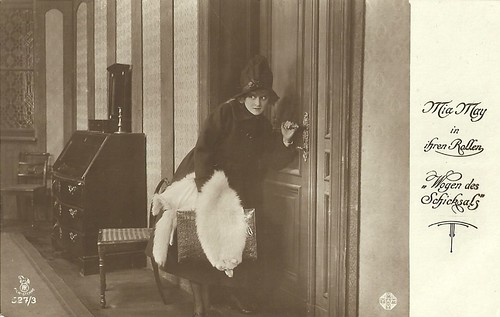
German postcard by Rotophot in the Film Sterne series, no. 527/3. Photo: May Film. Mia May in Wogen des Schicksals/Waves of Fate (Joe May, 1918).

German postcard by Ross Verlag, no. 634/6. Photo: May Film. Mia May in Die Herrin der Welt/Mistress of the World (Joe May and others, 1919).

German postcard by Rotophot in the Film-Sterne series, no. 566/2. Photo: May-Film. Publicity still for Veritas Vincit (Joe May, 1919). Caption: A scene from the First Part, The triumphal procession.
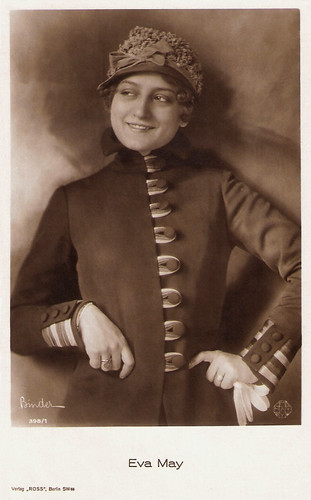
German postcard by Ross Verlag, Berlin, no. 398/1, 1919-1924. Photo: Alex Binder / May Film.
Eva May (1902-1924) was the daughter of film star Mia May and producer Joe May. It was only natural that she would follow suit. She became ‘everybody’s darling’ but in 1924 she committed suicide.
Joe May was born Otto Julius Mandl (according to IMDb, Joseph Otto Mandel) in Vienna, Austria-Hungary (now Austria), in 1880. He was born into a rich family. After his study in Berlin, he had many odd jobs. In 1902 he married the Viennese actress Mia May (born Hermine Pfleger) and later took his stage name from hers. In 1909, he worked as an operetta director in Hamburg, and there he got in touch with the film business. His entrance into the film business was an unusual one. When he directed the play 'Clo Clo' the intermissions were very long because of the reconstructions of the sets. Audiences did not know if the play had ended or not and sometimes left the theatre too early. Therefore Mandl got the idea to entertain the audience during the intermission with a short film with the actors of the play. Although inexperienced, he was able to make this film.
As Joe May, he then made ten films for Continental-Kunstfilm GmbH in Berlin. The first was In der Tiefe des Schachtes/In the Depths of the Pit (Joe May, 1912), in which Mia May made her film debut. It was followed by Vorglühen des Balkanbrandes/The Balkan Traitors (Joe May, 1912), starring Ernst Reicher. In the Spring of 1914, May directed the first three 'Stuart Webbs' films, a popular series in which Ernst Reicher played a gentleman detective modelled on Sherlock Holmes: Die geheimnisvolle Villa/The Black Triangle (Joe May, 1914), Der Mann im Keller/The Man in the Cellar (Joe May, 1914), and Der Spuk im Haus des Professors/The Spook in the Professor's House (Joe May, 1914). May and Reicher fell out with the managers of Continental over the 'Stuart Webbs' films, and they left Continental together. They formed their own production company, Webbs-Film, and made the next in the 'Stuart Webbs' series, Das Panzergewölbe/The Armoured Vault (Joe May, 1914), using Continental-Kunstfilm's new studios at 9 Franz Joseph-Strasse, Weissensee for the filming.
When the First World War broke out in August 1914, May had to return to his native Vienna to do his military service, and on his return to Berlin, he and Reicher split up. Ernst Reicher leased the studio at 9 Franz Joseph-Strasse from Continental and continued to make the 'Stuart Webbs' films with his Reicher & Reicher company until 1918. May's last film at Continental was Der geheimnisvolle Nachtschatten/The Secret Shadows of Night (1914) which he produced and Harry Piel directed. In 1915 he founded his own film production company, May-Film Gmb, and began to produce a successful series of crime films, whose detective hero went by the name of Joe Deebs. Some of these were directed by May himself, others by Harry Piel. Max Landa and later Harry Liedtke played the title role. May was not only active as a director and a producer but also as a screenwriter. For several screenplays, he used the pen name Fred Majo.
In 1917 May gave Fritz Lang one of his earliest breaks in the film industry as a screenwriter on Die Hochzeit im Excentricclub/Wedding in the Eccentric Club (Joe May, 1917), a film in the Joe Deebs series. Lang also worked on other May films at this time. May also discovered such talents as Thea von Harbou and E.A. Dupont for the cinema. After the end of the First World War, May-Film leased the double glasshouse studios belonging to Deutsche Vitascope in 1919, which became known as the May-Atelier. May also built a film studio in Woltersdorf a village northeast of Berlin in Brandenburg. There he continued to produce and direct a series of popular and exotic adventures, including the monumental Veritas vincit (Joe May, 1919), an epic in three episodes, similar to D. W. Griffith's Intolerance (1916), and the 8-part serial Die Herrin der Welt/Mistress of the World (Joe May, a.o., 1919-1920).
Another epic was the two-part adventure film Das indische Grabmal/The Indian Tomb (Joe May, 1921) starring Conrad Veidt and Lya de Putti. The film was scripted by Fritz Lang and Thea von Harbou. Upon its release, it was neither a critical nor commercial success and has been little seen until two recent restorations were recently completed. Mia May became a popular star in several melodramas under her husband's direction such as Hilde Warren und der Tod/Hilde Warren and Death (Joe May, 1917) and Tragödie der Liebe/The Tragedy of Love (1922-1923) with Emil Jannings. Their daughter Eva May, born in Vienna in 1902, was successful as an actress as well. Sadly, she committed suicide in 1924 after the failure of her three marriages with the film directors Manfred Liebenau, Lothar Mendes and Manfred Noa.

German postcard by Rotophot in the Film Sterne series, no. 94/3. Photo: Karl Schenker / Webbs Film. Ernst Reicher as Stuart Webbs.

German postcard by Photochemie, Berlin, no. K. 2019. Photo: Union-Film. Mia May in Charley, der Wunderaffe/Charley, the Magic Monkey (Joe May, 1915).

German postcard in the Film-Sterne series by Rotophot, no. 503/2. Photo: May Film. Mia May and Hans Mierendorff in Nebel und Sonne (Joe May, 1916). The film narrates about the martyrdom of a mother.
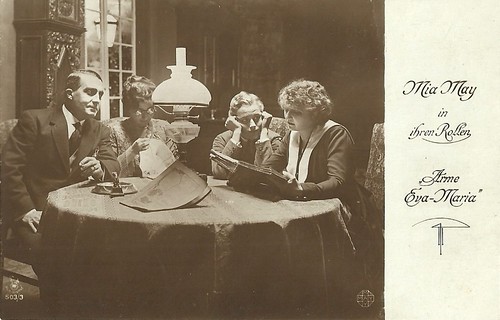
German postcard by Rotophot in the Film Sterne series, no. 503/3. Photo: May-Film. Mia May in Arme Eva Maria/Poor Eva Maria (Joe May 1916). Princess Eva Maria (Mia May) elopes to escape an arranged marriage with a prince and marries a painter, Hans Flotow (Harry Liedtke). Yet, Flotow proves to be unreliable and superficial, burns her capital, and dumps her for a singer. Deluded, Eva Maria returns to her class and marries a baron and landowner.
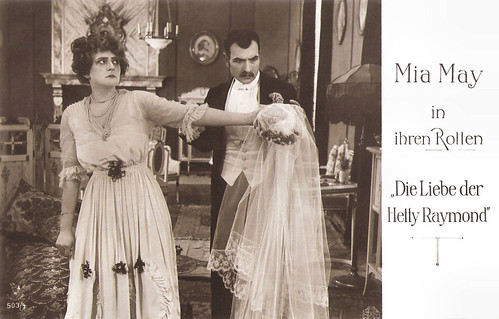
German postcard by Rotophot in the Film Sterne series, no. 503/4. Photo: May-Film. Mia May in Die Liebe der Hetty Raymond/The Love of Hetty Raymond (Joe May, 1917).

German postcard in the Film Sterne series by Rotophot, no. 503/5. Photo: May-Film. Mia May and Bruno Decarli in Die Silhouette des Teufels (Felix Basch, 1916-1917), produced and scripted by Joe May.

German postcard in the Film-Sterne series by Rotophot, no. 503/6. Photo: May Film. Mia May and Harry Liedtke in Ehre/Honour (Joe May?, Hans Oberländer?, 1917).
Towards the end of the 1920s, Joe May left the adventure genre and focused on realist films, such as Heimkehr/The Return Home (Joe May, 1928), with Dita Parlo, Lars Hanson, and Gustav Fröhlich, and the contemporary comical thriller Asphalt (Joe May, 1929), starring Gustav Fröhlich and Betty Amann. During the early sound film years, May worked as a producer for Erich Pommer at Ufa and afterwards for several other companies in Germany, Austria, and France, directing a series of multilanguage films in German and French. His Ihre Majestät die Liebe/Son Altesse l'amour (1930) was one of the best musical comedies of the Weimar era. It starred Käthe von Nagy and Franz Lederer in the German version and Annabella and Roger Tréville in the French version.
In 1933 May, his wife, and many colleagues emigrated to the US, where he was capable with the help of former Ufa chief Erich Pommer establishing himself as director and made Music in the Air (Joe May, 1934), based on Jerome Kern and Oscar Hammerstein II's Broadway musical of the same name. The film, starring Gloria Swanson, was a commercial failure, and May's later work at Universal Pictures, would never result in A-pictures. His next Hollywood film was the Kay Francis vehicle Confession (Joe May, 1937), an exact remake of the German film Mazurka (Willi Forst, 1935), starring Pola Negri, which Warner Brothers Studios acquired the U.S. distribution rights for and then shelved in favour of the remake. However, it was not a box-office success. May's later films were the Gothic drama The House of the Seven Gables (Joe May, 1940), and The Invisible Man Returns (Joe May, 1940) starring Vincent Price.
He also worked on two films with The Dead End Kids, You’re Not So Tough (Joe May, 1940), and Hit the Road (Joe May, 1941), despite friction with his young stars because of his dictatorial behaviour on the set. May also never bothered to completely learn the English language. His last film was Johnny Doesn’t Live Here Anymore (Joe May, 1944) with Simone Simon made by the King Brothers and released through Monogram Pictures. After his retirement in 1950, Joe May and his wife Mia ran for a short time The Blue Danube Restaurant in Los Angeles, which specialised in the Viennese kitchen. According to Doug Sederberg at IMDb, "It failed because, in keeping with his Teutonic roots, May told customers what they should order."
After the restaurant closed, May and his wife had to rely on the support of their friends and colleagues as well as the aid organization European Film Fund. Joe May died in 1954 after a long illness at the age of 67. He is interred in the Hollywood Forever Cemetery in Hollywood, California. Curd Goetz, who wrote some screenplays for the Joe Deebs Series, remembers the following anecdote in his autobiography: Joe May was directing a scene where, at the shore of a lake, an elephant was required to enter the camera's view from the side. However, the animal trainer did not manage to make it do so. May, fully immersed in making the scene, got impatient and started to pull the animal by its trunk. The elephant, more annoyed than angry, effortlessly picked him up and threw him, in a high arc, into the lake. May, airborne, only screamed: "Stay shooting!".
In November 2018, the Cinefest Festival and the CineGraph Congress in Hamburg presented Joe May as an important producer and film mogul. In addition, May's two-part Das indische Grabmal/The Indian Tomb (Joe May, 1921-1922), was restored by the Friedrich-Wilhelm-Murnau-Stiftung and appeared for the first time in Germany on DVD and Blu-ray in 2019.

German postcard by Rotophot in the Film Sterne series, no. 566/3. Photo: May Film. Mia May and Magnus Stifter in Veritas Vincit (Joe May, 1919). Caption: Decius' Wedding Night.
Veritas Vincit (Joe May, 1919) was a prestigious monumental, three-part film on the victory of truth through the ages. The first part evolves during Roman Antiquity, the second during the Middle Ages, and the last part takes place at a small European court shortly before the First World War. In the first two parts, the protagonists sign their fates because of insincerities, causing fate to take a tragic turn. In the modern episode, the female protagonist has learned from her predecessors. By being sincere she saves her love and conquers prejudice. The giant sets for the film were designed by Paul Leni. The film was shot during the last months of the First World War and premiered on 4 April 1919 in Berlin.
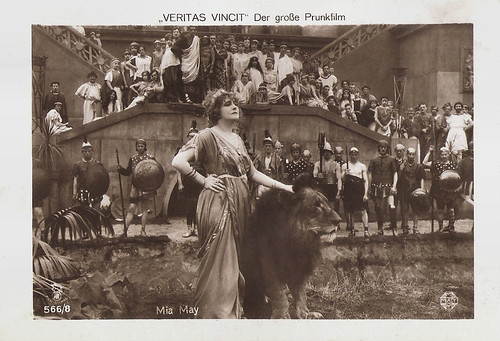
German postcard by Rotophot in the Film Sterne series, no. 566/8. Photo: May Film. Mia May in the first part of Veritas Vincit (Joe May, 1919).

German postcard in the Film Sterne series by Rotophot, no. 516/1, 1919-1924. Photo: May-Film. Mia May in Ein Lichtstrahl im Dunkel/A ray of light in the darkness (Joe May, 1917).
In Ein Lichtstrahl im Dunkel/A ray of light in the darkness (Joe May, 1917), Count Gerd Palm (Bruno Kastner) is known for his flattering portraits of his models, so Countess Lydia von Grabor (Mia May), who has a hideous nose, asks him to paint her. Gerd sees through her facade and paints her as a lovely mother. He is so enchanted by a song from her that he asks her to marry him. Lydia cannot believe him, so she flees. Years pass, the countess has her nose operated on and returns to Gerd, but discovers he has become blind. Dressed as a nurse she takes care of him. Her care makes him retake his work. He hears she is now ready to marry him, but when he still doubts she sings the song she once sang for him and they finally unite.

German postcard by Rotophot in the Film Sterne series, no. 516/2. Photo: May-Film. Mia May and Bruno Kastner in Ein Lichtstrahl im Dunkel/A Ray of Light in the Dark (Joe May, 1917).

German postcard by Rotophot in the Film Sterne series, no. 516/3, 1919-1924. Photo: May-Film. Mia May and Bruno Kastner in Hilde Warren und der Tod/Hilde Warren and Death (Joe May, 1917), scripted by Fritz Lang.
In Hilde Warren und der Tod/Hilde Warren and Death (Joe May, 1917), the famous actress Hilde Warren (Mia May) rejects the marriage proposal of her theatre manager (Hans Mierendorff), preferring her art. When Death (Georg John) tempts her, she rejects him. She falls in love with the handsome criminal Hector Roger (Bruno Kastner), who dies in a shootout with the police. Hilde is desperate when she discovers she is bearing his child, so Death visits her again, but in vain. Years after, the father’s vices seem inherited in their son Egon, and Hilde feels she is responsible. The theatre manager still wants to marry Hilde, but she cannot accept his condition to abandon her son. Death visits her a third time but to no avail. The spoiled Egon (Ernst Matray), once an adult, turns into a criminal when Hilde refuses him money. Fleeing for the police, he asks his mother for money to get away, but she menaces him with a gun. In a fight, she shoots him. Condemned to jail, she finally welcomes Death.

German postcard by Rotophot in the Film Sterne series, no. 516/4, 1919-1924. Photo: May-Film. Mia May and Ernst Matray in Hilde Warren und der Tod/Hilde Warren and Death (Joe May, 1917), scripted by Fritz Lang.

German postcard by Rotophot in the Film Sterne series, no. 527/5. Photo: May Film. Mia May in Wogen des Schicksals/Waves of Fate (Joe May, 1918). The man on the dance floor singing to her is Erich Kaiser-Titz, while the man sitting next to Mia May is Rolf Brunner.
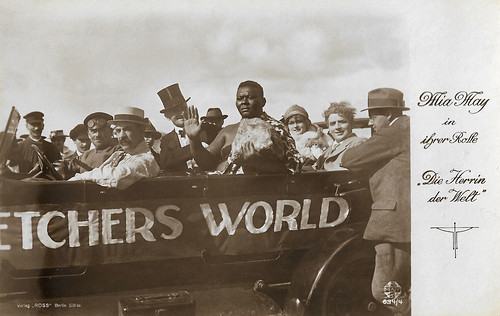
German postcard by Ross Verlag, no. 634/6. Photo: May Film. Mia May and Michael Bohnen in Die Herrin der Welt/Mistress of the World (Joe May and others, 1919). The man with the top hat is Hermann Picha, who plays newspaper mogul Jonathan Fletcher.
In 1919, Joe May, Joseph Klein, Uwe Jenss Krafft, and Karl Gerhardt shot the various episodes for the eight-part German silent serial Die Herrin der Welt, one of the most notable adventure series of the Weimar cinema and considered the first monumental film in German film history. The Star of the film was Mia May, her male film partner was played by Michael Bohnen. May shot episodes 1, 2, 3, and 8, Krafft 4 to 6, and Gerhardt 7. Klein was co-director for parts 1 and 4. The Indiana Jones-like story follows the young Maud Gregaard on her globe-trotting adventures to find the legendary lost treasure of the Queen of Sheba. She hopes it will enable her to bring revenge on the man who drew her father to commit suicide and led to her own social destruction. All eight parts were full-length. Even if self-sustaining features they referred to future developments though without American-styled cliffhangers. Even if part of the press was critical, German audiences loved it and it was a bigger box office than the contemporary The Cabinet of Dr. Caligari.

German postcard by Ross Verlag, no. 634/1. Photo: May Film. Mia May and Michael Bohnen in Die Herrin der Welt/Mistress of the World (Joe May and others, 1919).

German postcard by Ross Verlag, no. 539/1. Photo: May-Film. Conrad Veidt is the proud and cruel Maharajah of Eschnapur in the two-part monumental film Das indische Grabmal/The Indian Tomb (Joe May, 1921-1922).

German postcard by Ross Verlag, Berlin, no. 567/1, 1919-1924. Photo: May-Film. Lya de Putti as the slave Mirrjha in Das Indische Grabmal/The Indian Tomb (Joe May, 1921). Collection: Didier Hanson.

German postcard by Ross Verlag, no. 654/1. Photo: May Film. Erika Glässner and Emil Jannings in Tragödie der Liebe/The Tragedy of Love (Joe May, 1923).
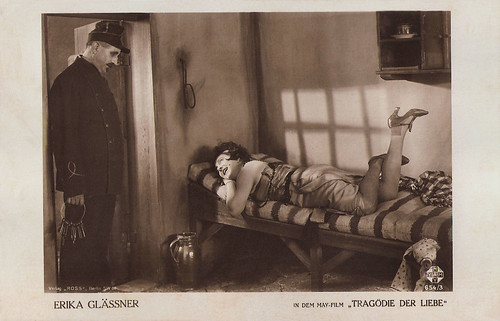
German postcard by Ross Verlag, no. 654/3. Photo: May Film. Erika Glässner in Tragödie der Liebe/The Tragedy of Love (Joe May, 1923).

Austrian postcard by Iris Verlag, no. 6118. Photo: Distr. Hugo Engel-Film / May Film. Käthe von Nagy in Ihre Majestät, die Liebe/Her Majesty Love (Joe May, 1931).

Dutch postcard, no. 610. Photo: Metro Goldwyn Mayer. In 1934, Gloria Swanson did a photoshoot involving this tiger rug and hairdo, before acting in the Jerome Kern musical Music in the Air (Joe May, 1934). While some sources say the photos were taken by Clarence Sinclair Bull, other sources don't mention the photographer.
Sources: Doug Sederberg (IMDb), Wikipedia (French, German, and English), and IMDb.

German postcard by Rotophot in the Film Sterne series, no. 101. Photo: Karl Schenker / May-Film. Joe May.

German postcard by Ross Verlag, no. 972/1, 1925-1926. Photo: May-Film. Joe May.

German postcard by Rotophot in the Film Sterne series, no. 527/3. Photo: May Film. Mia May in Wogen des Schicksals/Waves of Fate (Joe May, 1918).

German postcard by Ross Verlag, no. 634/6. Photo: May Film. Mia May in Die Herrin der Welt/Mistress of the World (Joe May and others, 1919).

German postcard by Rotophot in the Film-Sterne series, no. 566/2. Photo: May-Film. Publicity still for Veritas Vincit (Joe May, 1919). Caption: A scene from the First Part, The triumphal procession.

German postcard by Ross Verlag, Berlin, no. 398/1, 1919-1924. Photo: Alex Binder / May Film.
Eva May (1902-1924) was the daughter of film star Mia May and producer Joe May. It was only natural that she would follow suit. She became ‘everybody’s darling’ but in 1924 she committed suicide.
A series of popular and exotic adventures
Joe May was born Otto Julius Mandl (according to IMDb, Joseph Otto Mandel) in Vienna, Austria-Hungary (now Austria), in 1880. He was born into a rich family. After his study in Berlin, he had many odd jobs. In 1902 he married the Viennese actress Mia May (born Hermine Pfleger) and later took his stage name from hers. In 1909, he worked as an operetta director in Hamburg, and there he got in touch with the film business. His entrance into the film business was an unusual one. When he directed the play 'Clo Clo' the intermissions were very long because of the reconstructions of the sets. Audiences did not know if the play had ended or not and sometimes left the theatre too early. Therefore Mandl got the idea to entertain the audience during the intermission with a short film with the actors of the play. Although inexperienced, he was able to make this film.
As Joe May, he then made ten films for Continental-Kunstfilm GmbH in Berlin. The first was In der Tiefe des Schachtes/In the Depths of the Pit (Joe May, 1912), in which Mia May made her film debut. It was followed by Vorglühen des Balkanbrandes/The Balkan Traitors (Joe May, 1912), starring Ernst Reicher. In the Spring of 1914, May directed the first three 'Stuart Webbs' films, a popular series in which Ernst Reicher played a gentleman detective modelled on Sherlock Holmes: Die geheimnisvolle Villa/The Black Triangle (Joe May, 1914), Der Mann im Keller/The Man in the Cellar (Joe May, 1914), and Der Spuk im Haus des Professors/The Spook in the Professor's House (Joe May, 1914). May and Reicher fell out with the managers of Continental over the 'Stuart Webbs' films, and they left Continental together. They formed their own production company, Webbs-Film, and made the next in the 'Stuart Webbs' series, Das Panzergewölbe/The Armoured Vault (Joe May, 1914), using Continental-Kunstfilm's new studios at 9 Franz Joseph-Strasse, Weissensee for the filming.
When the First World War broke out in August 1914, May had to return to his native Vienna to do his military service, and on his return to Berlin, he and Reicher split up. Ernst Reicher leased the studio at 9 Franz Joseph-Strasse from Continental and continued to make the 'Stuart Webbs' films with his Reicher & Reicher company until 1918. May's last film at Continental was Der geheimnisvolle Nachtschatten/The Secret Shadows of Night (1914) which he produced and Harry Piel directed. In 1915 he founded his own film production company, May-Film Gmb, and began to produce a successful series of crime films, whose detective hero went by the name of Joe Deebs. Some of these were directed by May himself, others by Harry Piel. Max Landa and later Harry Liedtke played the title role. May was not only active as a director and a producer but also as a screenwriter. For several screenplays, he used the pen name Fred Majo.
In 1917 May gave Fritz Lang one of his earliest breaks in the film industry as a screenwriter on Die Hochzeit im Excentricclub/Wedding in the Eccentric Club (Joe May, 1917), a film in the Joe Deebs series. Lang also worked on other May films at this time. May also discovered such talents as Thea von Harbou and E.A. Dupont for the cinema. After the end of the First World War, May-Film leased the double glasshouse studios belonging to Deutsche Vitascope in 1919, which became known as the May-Atelier. May also built a film studio in Woltersdorf a village northeast of Berlin in Brandenburg. There he continued to produce and direct a series of popular and exotic adventures, including the monumental Veritas vincit (Joe May, 1919), an epic in three episodes, similar to D. W. Griffith's Intolerance (1916), and the 8-part serial Die Herrin der Welt/Mistress of the World (Joe May, a.o., 1919-1920).
Another epic was the two-part adventure film Das indische Grabmal/The Indian Tomb (Joe May, 1921) starring Conrad Veidt and Lya de Putti. The film was scripted by Fritz Lang and Thea von Harbou. Upon its release, it was neither a critical nor commercial success and has been little seen until two recent restorations were recently completed. Mia May became a popular star in several melodramas under her husband's direction such as Hilde Warren und der Tod/Hilde Warren and Death (Joe May, 1917) and Tragödie der Liebe/The Tragedy of Love (1922-1923) with Emil Jannings. Their daughter Eva May, born in Vienna in 1902, was successful as an actress as well. Sadly, she committed suicide in 1924 after the failure of her three marriages with the film directors Manfred Liebenau, Lothar Mendes and Manfred Noa.

German postcard by Rotophot in the Film Sterne series, no. 94/3. Photo: Karl Schenker / Webbs Film. Ernst Reicher as Stuart Webbs.

German postcard by Photochemie, Berlin, no. K. 2019. Photo: Union-Film. Mia May in Charley, der Wunderaffe/Charley, the Magic Monkey (Joe May, 1915).

German postcard in the Film-Sterne series by Rotophot, no. 503/2. Photo: May Film. Mia May and Hans Mierendorff in Nebel und Sonne (Joe May, 1916). The film narrates about the martyrdom of a mother.

German postcard by Rotophot in the Film Sterne series, no. 503/3. Photo: May-Film. Mia May in Arme Eva Maria/Poor Eva Maria (Joe May 1916). Princess Eva Maria (Mia May) elopes to escape an arranged marriage with a prince and marries a painter, Hans Flotow (Harry Liedtke). Yet, Flotow proves to be unreliable and superficial, burns her capital, and dumps her for a singer. Deluded, Eva Maria returns to her class and marries a baron and landowner.

German postcard by Rotophot in the Film Sterne series, no. 503/4. Photo: May-Film. Mia May in Die Liebe der Hetty Raymond/The Love of Hetty Raymond (Joe May, 1917).

German postcard in the Film Sterne series by Rotophot, no. 503/5. Photo: May-Film. Mia May and Bruno Decarli in Die Silhouette des Teufels (Felix Basch, 1916-1917), produced and scripted by Joe May.

German postcard in the Film-Sterne series by Rotophot, no. 503/6. Photo: May Film. Mia May and Harry Liedtke in Ehre/Honour (Joe May?, Hans Oberländer?, 1917).
Frictions about his dictatorial behaviour on the set
Towards the end of the 1920s, Joe May left the adventure genre and focused on realist films, such as Heimkehr/The Return Home (Joe May, 1928), with Dita Parlo, Lars Hanson, and Gustav Fröhlich, and the contemporary comical thriller Asphalt (Joe May, 1929), starring Gustav Fröhlich and Betty Amann. During the early sound film years, May worked as a producer for Erich Pommer at Ufa and afterwards for several other companies in Germany, Austria, and France, directing a series of multilanguage films in German and French. His Ihre Majestät die Liebe/Son Altesse l'amour (1930) was one of the best musical comedies of the Weimar era. It starred Käthe von Nagy and Franz Lederer in the German version and Annabella and Roger Tréville in the French version.
In 1933 May, his wife, and many colleagues emigrated to the US, where he was capable with the help of former Ufa chief Erich Pommer establishing himself as director and made Music in the Air (Joe May, 1934), based on Jerome Kern and Oscar Hammerstein II's Broadway musical of the same name. The film, starring Gloria Swanson, was a commercial failure, and May's later work at Universal Pictures, would never result in A-pictures. His next Hollywood film was the Kay Francis vehicle Confession (Joe May, 1937), an exact remake of the German film Mazurka (Willi Forst, 1935), starring Pola Negri, which Warner Brothers Studios acquired the U.S. distribution rights for and then shelved in favour of the remake. However, it was not a box-office success. May's later films were the Gothic drama The House of the Seven Gables (Joe May, 1940), and The Invisible Man Returns (Joe May, 1940) starring Vincent Price.
He also worked on two films with The Dead End Kids, You’re Not So Tough (Joe May, 1940), and Hit the Road (Joe May, 1941), despite friction with his young stars because of his dictatorial behaviour on the set. May also never bothered to completely learn the English language. His last film was Johnny Doesn’t Live Here Anymore (Joe May, 1944) with Simone Simon made by the King Brothers and released through Monogram Pictures. After his retirement in 1950, Joe May and his wife Mia ran for a short time The Blue Danube Restaurant in Los Angeles, which specialised in the Viennese kitchen. According to Doug Sederberg at IMDb, "It failed because, in keeping with his Teutonic roots, May told customers what they should order."
After the restaurant closed, May and his wife had to rely on the support of their friends and colleagues as well as the aid organization European Film Fund. Joe May died in 1954 after a long illness at the age of 67. He is interred in the Hollywood Forever Cemetery in Hollywood, California. Curd Goetz, who wrote some screenplays for the Joe Deebs Series, remembers the following anecdote in his autobiography: Joe May was directing a scene where, at the shore of a lake, an elephant was required to enter the camera's view from the side. However, the animal trainer did not manage to make it do so. May, fully immersed in making the scene, got impatient and started to pull the animal by its trunk. The elephant, more annoyed than angry, effortlessly picked him up and threw him, in a high arc, into the lake. May, airborne, only screamed: "Stay shooting!".
In November 2018, the Cinefest Festival and the CineGraph Congress in Hamburg presented Joe May as an important producer and film mogul. In addition, May's two-part Das indische Grabmal/The Indian Tomb (Joe May, 1921-1922), was restored by the Friedrich-Wilhelm-Murnau-Stiftung and appeared for the first time in Germany on DVD and Blu-ray in 2019.

German postcard by Rotophot in the Film Sterne series, no. 566/3. Photo: May Film. Mia May and Magnus Stifter in Veritas Vincit (Joe May, 1919). Caption: Decius' Wedding Night.
Veritas Vincit (Joe May, 1919) was a prestigious monumental, three-part film on the victory of truth through the ages. The first part evolves during Roman Antiquity, the second during the Middle Ages, and the last part takes place at a small European court shortly before the First World War. In the first two parts, the protagonists sign their fates because of insincerities, causing fate to take a tragic turn. In the modern episode, the female protagonist has learned from her predecessors. By being sincere she saves her love and conquers prejudice. The giant sets for the film were designed by Paul Leni. The film was shot during the last months of the First World War and premiered on 4 April 1919 in Berlin.

German postcard by Rotophot in the Film Sterne series, no. 566/8. Photo: May Film. Mia May in the first part of Veritas Vincit (Joe May, 1919).

German postcard in the Film Sterne series by Rotophot, no. 516/1, 1919-1924. Photo: May-Film. Mia May in Ein Lichtstrahl im Dunkel/A ray of light in the darkness (Joe May, 1917).
In Ein Lichtstrahl im Dunkel/A ray of light in the darkness (Joe May, 1917), Count Gerd Palm (Bruno Kastner) is known for his flattering portraits of his models, so Countess Lydia von Grabor (Mia May), who has a hideous nose, asks him to paint her. Gerd sees through her facade and paints her as a lovely mother. He is so enchanted by a song from her that he asks her to marry him. Lydia cannot believe him, so she flees. Years pass, the countess has her nose operated on and returns to Gerd, but discovers he has become blind. Dressed as a nurse she takes care of him. Her care makes him retake his work. He hears she is now ready to marry him, but when he still doubts she sings the song she once sang for him and they finally unite.

German postcard by Rotophot in the Film Sterne series, no. 516/2. Photo: May-Film. Mia May and Bruno Kastner in Ein Lichtstrahl im Dunkel/A Ray of Light in the Dark (Joe May, 1917).

German postcard by Rotophot in the Film Sterne series, no. 516/3, 1919-1924. Photo: May-Film. Mia May and Bruno Kastner in Hilde Warren und der Tod/Hilde Warren and Death (Joe May, 1917), scripted by Fritz Lang.
In Hilde Warren und der Tod/Hilde Warren and Death (Joe May, 1917), the famous actress Hilde Warren (Mia May) rejects the marriage proposal of her theatre manager (Hans Mierendorff), preferring her art. When Death (Georg John) tempts her, she rejects him. She falls in love with the handsome criminal Hector Roger (Bruno Kastner), who dies in a shootout with the police. Hilde is desperate when she discovers she is bearing his child, so Death visits her again, but in vain. Years after, the father’s vices seem inherited in their son Egon, and Hilde feels she is responsible. The theatre manager still wants to marry Hilde, but she cannot accept his condition to abandon her son. Death visits her a third time but to no avail. The spoiled Egon (Ernst Matray), once an adult, turns into a criminal when Hilde refuses him money. Fleeing for the police, he asks his mother for money to get away, but she menaces him with a gun. In a fight, she shoots him. Condemned to jail, she finally welcomes Death.

German postcard by Rotophot in the Film Sterne series, no. 516/4, 1919-1924. Photo: May-Film. Mia May and Ernst Matray in Hilde Warren und der Tod/Hilde Warren and Death (Joe May, 1917), scripted by Fritz Lang.

German postcard by Rotophot in the Film Sterne series, no. 527/5. Photo: May Film. Mia May in Wogen des Schicksals/Waves of Fate (Joe May, 1918). The man on the dance floor singing to her is Erich Kaiser-Titz, while the man sitting next to Mia May is Rolf Brunner.

German postcard by Ross Verlag, no. 634/6. Photo: May Film. Mia May and Michael Bohnen in Die Herrin der Welt/Mistress of the World (Joe May and others, 1919). The man with the top hat is Hermann Picha, who plays newspaper mogul Jonathan Fletcher.
In 1919, Joe May, Joseph Klein, Uwe Jenss Krafft, and Karl Gerhardt shot the various episodes for the eight-part German silent serial Die Herrin der Welt, one of the most notable adventure series of the Weimar cinema and considered the first monumental film in German film history. The Star of the film was Mia May, her male film partner was played by Michael Bohnen. May shot episodes 1, 2, 3, and 8, Krafft 4 to 6, and Gerhardt 7. Klein was co-director for parts 1 and 4. The Indiana Jones-like story follows the young Maud Gregaard on her globe-trotting adventures to find the legendary lost treasure of the Queen of Sheba. She hopes it will enable her to bring revenge on the man who drew her father to commit suicide and led to her own social destruction. All eight parts were full-length. Even if self-sustaining features they referred to future developments though without American-styled cliffhangers. Even if part of the press was critical, German audiences loved it and it was a bigger box office than the contemporary The Cabinet of Dr. Caligari.

German postcard by Ross Verlag, no. 634/1. Photo: May Film. Mia May and Michael Bohnen in Die Herrin der Welt/Mistress of the World (Joe May and others, 1919).

German postcard by Ross Verlag, no. 539/1. Photo: May-Film. Conrad Veidt is the proud and cruel Maharajah of Eschnapur in the two-part monumental film Das indische Grabmal/The Indian Tomb (Joe May, 1921-1922).

German postcard by Ross Verlag, Berlin, no. 567/1, 1919-1924. Photo: May-Film. Lya de Putti as the slave Mirrjha in Das Indische Grabmal/The Indian Tomb (Joe May, 1921). Collection: Didier Hanson.

German postcard by Ross Verlag, no. 654/1. Photo: May Film. Erika Glässner and Emil Jannings in Tragödie der Liebe/The Tragedy of Love (Joe May, 1923).

German postcard by Ross Verlag, no. 654/3. Photo: May Film. Erika Glässner in Tragödie der Liebe/The Tragedy of Love (Joe May, 1923).

Austrian postcard by Iris Verlag, no. 6118. Photo: Distr. Hugo Engel-Film / May Film. Käthe von Nagy in Ihre Majestät, die Liebe/Her Majesty Love (Joe May, 1931).

Dutch postcard, no. 610. Photo: Metro Goldwyn Mayer. In 1934, Gloria Swanson did a photoshoot involving this tiger rug and hairdo, before acting in the Jerome Kern musical Music in the Air (Joe May, 1934). While some sources say the photos were taken by Clarence Sinclair Bull, other sources don't mention the photographer.
Sources: Doug Sederberg (IMDb), Wikipedia (French, German, and English), and IMDb.
No comments:
Post a Comment